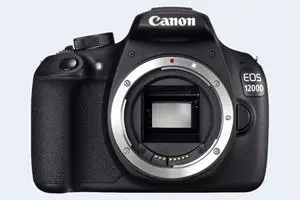Canon 1200D vs Ricoh WG-6
The Canon EOS 1200D (called Canon T5 in some regions) and the Ricoh WG-6 are two digital cameras that were officially introduced, respectively, in February 2014 and February 2019. The 1200D is a DSLR, while the WG-6 is a fixed lens compact. The cameras are based on an APS-C (1200D) and a 1/2.3-inch (WG-6) sensor. The Canon has a resolution of 17.9 megapixels, whereas the Ricoh provides 20.2 MP.
Below is an overview of the main specs of the two cameras as a starting point for the comparison.

Check 1200D offers at
ebay.com

Check WG-6 price at
amazon.com
Going beyond this snapshot of core features and characteristics, what are the differences between the Canon EOS 1200D and the Ricoh WG-6? Which one should you buy? Read on to find out how these two cameras compare with respect to their body size, their imaging sensors, their shooting features, their input-output connections, and their reception by expert reviewers.
Body comparison
The physical size and weight of the Canon 1200D and the Ricoh WG-6 are illustrated in the side-by-side display below. The two cameras are presented according to their relative size. Three consecutive views from the front, the top, and the rear side are shown. All width, height and depth dimensions are rounded to the nearest millimeter.
The WG-6 can be obtained in two different colors (black, orange), while the 1200D is only available in black.
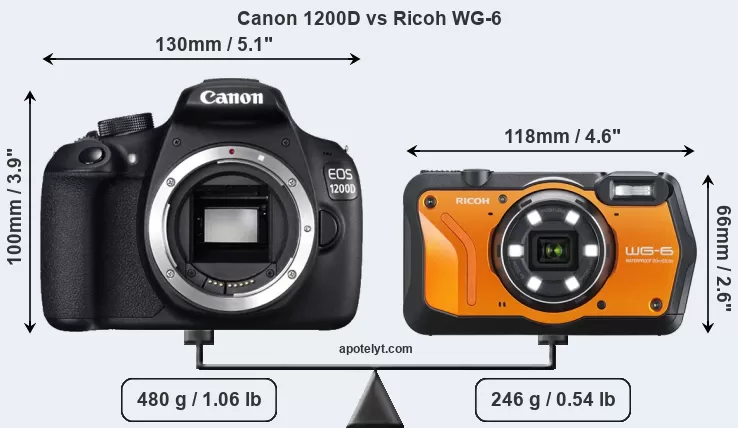
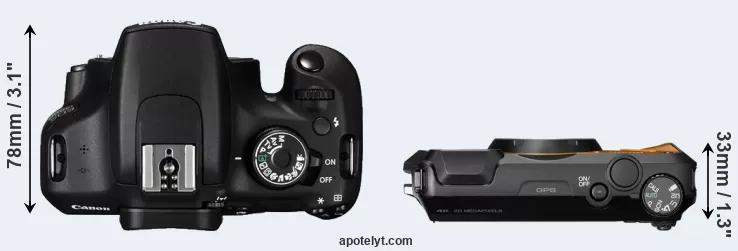
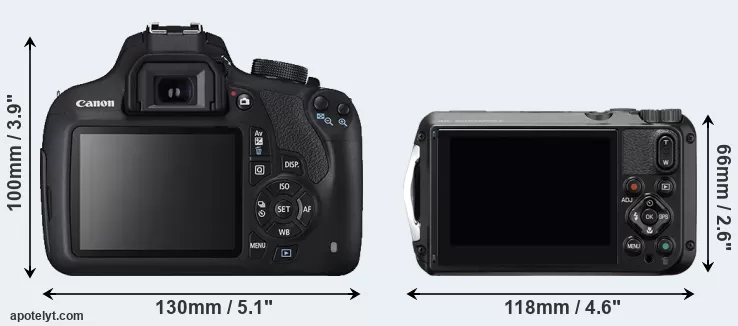
If the front view area (width x height) of the cameras is taken as an aggregate measure of their size, the Ricoh WG-6 is considerably smaller (40 percent) than the Canon 1200D. It is noteworthy in this context that the WG-6 is splash and dust-proof, while the 1200D does not feature any corresponding weather-sealing. More than that, the WG-6 is water-proof up to 20m and can, thus, be used for underwater photography.
The above size and weight comparisons are to some extent incomplete and possibly misleading, as the WG-6 has a lens built in, whereas the 1200D is an interchangeable lens camera that requires a separate lens. Attaching the latter will add extra weight and bulk to the setup. You can compare the optics available for the 1200D and their specifications in the Canon EF Lens Catalog.
Concerning battery life, the 1200D gets 500 shots out of its Canon LP-E10 battery, while the WG-6 can take 340 images on a single charge of its Ricoh DB-110 power pack. The power pack in the WG-6 can be charged via the USB port, which can be very convenient when travelling.
The adjacent table lists the principal physical characteristics of the two cameras alongside a wider set of alternatives. If you would like to visualize and compare a different camera combination, you can navigate to the CAM-parator app and make your selection from a broad list of cameras there.

| Camera Model |
Camera Width |
Camera Height |
Camera Depth |
Camera Weight |
Battery Life |
Weather Sealing |
Camera Launch |
Launch Price |
Street Price |
||
|---|---|---|---|---|---|---|---|---|---|---|---|
| 1. | Canon 1200D | 130 mm | 100 mm | 78 mm | 480 g | 500 | n | Feb 2014 | US$ 449 | ebay.com | |
| 2. | Ricoh WG-6 | 118 mm | 66 mm | 33 mm | 246 g | 340 | Y | Feb 2019 | US$ 399 | amazon.com | |
| 3. | Canon 100D | 117 mm | 91 mm | 69 mm | 407 g | 380 | n | Mar 2013 | US$ 549 | ebay.com | |
| 4. | Canon 650D | 133 mm | 100 mm | 79 mm | 575 g | 440 | n | Jun 2012 | US$ 849 | ebay.com | |
| 5. | Canon 700D | 133 mm | 100 mm | 79 mm | 580 g | 440 | n | Mar 2013 | US$ 649 | ebay.com | |
| 6. | Canon 750D | 132 mm | 101 mm | 78 mm | 555 g | 440 | n | Feb 2015 | US$ 749 | ebay.com | |
| 7. | Canon 760D | 132 mm | 101 mm | 78 mm | 565 g | 440 | n | Feb 2015 | US$ 649 | ebay.com | |
| 8. | Canon 1100D | 130 mm | 100 mm | 78 mm | 495 g | 700 | n | Feb 2011 | US$ 449 | ebay.com | |
| 9. | Canon 1300D | 129 mm | 101 mm | 78 mm | 485 g | 500 | n | Mar 2016 | US$ 449 | ebay.com | |
| 10. | Canon 4000D | 129 mm | 102 mm | 77 mm | 436 g | 500 | n | Feb 2018 | US$ 399 | amazon.com | |
| 11. | Canon G9 X | 98 mm | 58 mm | 31 mm | 209 g | 220 | n | Oct 2015 | US$ 529 | ebay.com | |
| 12. | Canon M10 | 108 mm | 67 mm | 35 mm | 301 g | 255 | n | Oct 2015 | US$ 499 | ebay.com | |
| 13. | Canon SX740 | 110 mm | 64 mm | 40 mm | 299 g | 265 | n | Jul 2018 | US$ 399 | amazon.com | |
| 14. | Panasonic TS7 | 117 mm | 76 mm | 37 mm | 319 g | 300 | Y | May 2018 | US$ 449 | ebay.com | |
| 15. | Sony HX95 | 102 mm | 58 mm | 36 mm | 242 g | 370 | n | Aug 2018 | US$ 429 | ebay.com | |
| 16. | Sony HX99 | 102 mm | 58 mm | 36 mm | 242 g | 370 | n | Aug 2018 | US$ 449 | ebay.com | |
| 17. | Sony WX800 | 102 mm | 58 mm | 36 mm | 233 g | 370 | n | Oct 2018 | US$ 399 | ebay.com | |
| Note: Measurements and pricing do not include easily detachable parts, such as add-on or interchangeable lenses or optional viewfinders. | |||||||||||
Any camera decision will obviously take relative prices into account. The manufacturer’s suggested retail prices give an idea on the placement of the camera in the maker’s lineup and the broader market. The WG-6 was launched at a lower price than the 1200D, despite having a lens built in. Usually, retail prices stay at first close to the launch price, but after several months, discounts become available. Later in the product cycle and, in particular, when the replacement model is about to appear, further discounting and stock clearance sales often push the camera price considerably down.
Sensor comparison
The imaging sensor is at the core of digital cameras and its size is one of the main determining factors of image quality. A large sensor will tend to have larger individual pixels that provide better low-light sensitivity, wider dynamic range, and richer color-depth than smaller pixel-units in a sensor of the same technological generation. Further, a large sensor camera will give the photographer additional creative options when using shallow depth-of-field to isolate a subject from its background. On the downside, larger sensors tend to be associated with larger, more expensive camera bodies and lenses.
Of the two cameras under consideration, the Canon 1200D features an APS-C sensor and the Ricoh WG-6 a 1/2.3-inch sensor. The sensor area in the WG-6 is 92 percent smaller. As a result of these sensor size differences, the cameras have a format factor of, respectively, 1.6 and 5.6. The sensor in the 1200D has a native 3:2 aspect ratio, while the one in the WG-6 offers a 4:3 aspect.
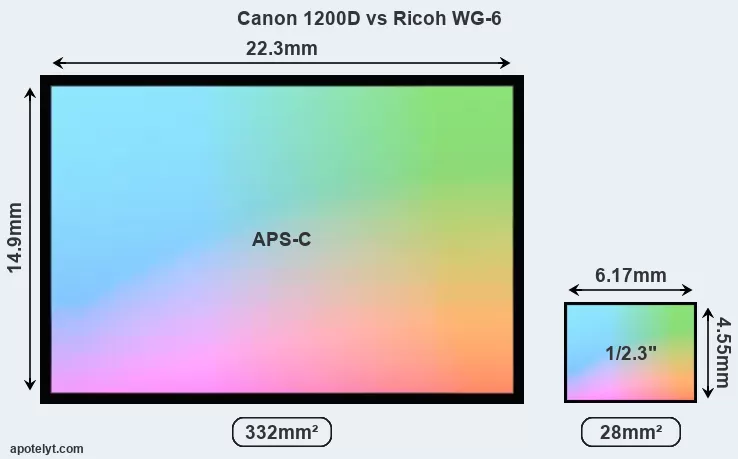
Despite having a smaller sensor, the WG-6 offers a higher resolution of 20.2 megapixels, compared with 17.9 MP of the 1200D. This megapixels advantage comes at the cost of a higher pixel density and a smaller size of the individual pixel (with a pixel pitch of 1.18μm versus 4.31μm for the 1200D). However, it should be noted that the WG-6 is much more recent (by 5 years) than the 1200D, and its sensor will have benefitted from technological advances during this time that make it possible to gather light more efficiently. Coming back to sensor resolution, it should be mentioned that the WG-6 has no anti-alias filter installed, so that it can capture all the detail its sensor resolves.
The Canon EOS 1200D has a native sensitivity range from ISO 100 to ISO 6400, which can be extended to ISO 100-12800. The corresponding ISO settings for the Ricoh WG-6 are ISO 125 to ISO 6400 (no boost).
In terms of underlying technology, the 1200D is build around a CMOS sensor, while the WG-6 uses a BSI-CMOS imager. Both cameras use a Bayer filter for capturing RGB colors on a square grid of photosensors. This arrangement is found in most digital cameras.
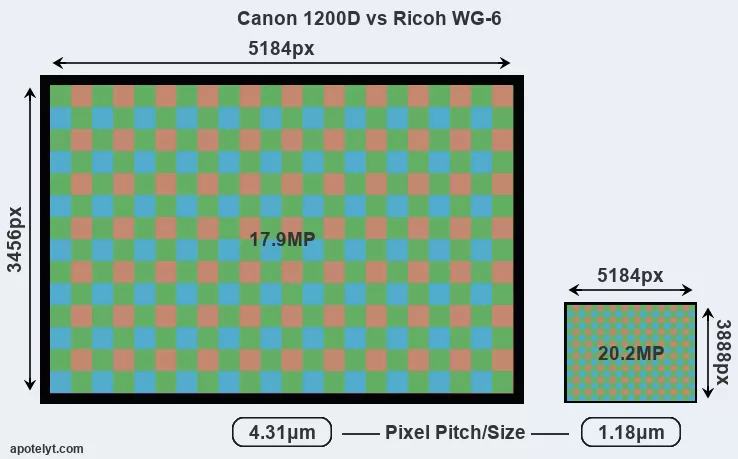
Consistent information on actual sensor performance is available from DXO Mark for many cameras. This service assesses and scores the color depth ("DXO Portrait"), dynamic range ("DXO Landscape"), and low-light sensitivity ("DXO Sports") of camera sensors, and also publishes an overall camera score. The adjacent table reports on the physical sensor characteristics and the outcomes of the DXO sensor quality tests for a sample of comparator-cameras.

| Camera Model |
Sensor Class |
Resolution (MP) |
Horiz. Pixels |
Vert. Pixels |
Video Format |
DXO Portrait |
DXO Landscape |
DXO Sports |
DXO Overall |
||
|---|---|---|---|---|---|---|---|---|---|---|---|
| 1. | Canon 1200D | APS-C | 17.9 | 5184 | 3456 | 1080/30p | 21.9 | 11.3 | 724 | 63 | |
| 2. | Ricoh WG-6 | 1/2.3 | 20.2 | 5184 | 3888 | 4K/30p | 20.7 | 12.2 | 1104 | 52 | |
| 3. | Canon 100D | APS-C | 17.9 | 5184 | 3456 | 1080/30p | 21.8 | 11.3 | 843 | 63 | |
| 4. | Canon 650D | APS-C | 17.9 | 5184 | 3456 | 1080/30p | 21.7 | 11.2 | 722 | 62 | |
| 5. | Canon 700D | APS-C | 17.9 | 5184 | 3456 | 1080/30p | 21.7 | 11.2 | 681 | 61 | |
| 6. | Canon 750D | APS-C | 24.0 | 6000 | 4000 | 1080/30p | 22.7 | 12.0 | 919 | 71 | |
| 7. | Canon 760D | APS-C | 24.0 | 6000 | 4000 | 1080/30p | 22.6 | 12.0 | 915 | 70 | |
| 8. | Canon 1100D | APS-C | 12.2 | 4272 | 2848 | 720/30p | 21.9 | 11.0 | 755 | 62 | |
| 9. | Canon 1300D | APS-C | 17.9 | 5184 | 3456 | 1080/30p | 22.0 | 11.7 | 781 | 66 | |
| 10. | Canon 4000D | APS-C | 17.9 | 5184 | 3456 | 1080/30p | 21.9 | 11.4 | 695 | 63 | |
| 11. | Canon G9 X | 1-inch | 20.0 | 5472 | 3648 | 1080/60p | 21.5 | 12.3 | 495 | 63 | |
| 12. | Canon M10 | APS-C | 17.9 | 5184 | 3456 | 1080/30p | 22.2 | 11.4 | 753 | 65 | |
| 13. | Canon SX740 | 1/2.3 | 20.2 | 5184 | 3888 | 4K/30p | 20.6 | 12.1 | 1050 | 51 | |
| 14. | Panasonic TS7 | 1/2.3 | 20.2 | 5184 | 3888 | 4K/30p | 20.6 | 12.1 | 1028 | 51 | |
| 15. | Sony HX95 | 1/2.3 | 18.0 | 4896 | 3672 | 4K/30p | 20.6 | 12.1 | 1057 | 51 | |
| 16. | Sony HX99 | 1/2.3 | 18.0 | 4896 | 3672 | 4K/30p | 20.6 | 12.1 | 1058 | 51 | |
| 17. | Sony WX800 | 1/2.3 | 18.0 | 4896 | 3672 | 4K/30p | 20.6 | 12.2 | 1070 | 51 | |
| Note: DXO values in italics represent estimates based on sensor size and age. | |||||||||||
Many modern cameras cannot only take still pictures, but also record videos. Both cameras under consideration are equipped with sensors that have a sufficiently high read-out speed for moving images, but the WG-6 provides a better video resolution than the 1200D. It can shoot movie footage at 4K/30p, while the Canon is limited to 1080/30p.
Feature comparison
Beyond body and sensor, cameras can and do differ across a range of features. For example, the 1200D has an optical viewfinder, which can be very useful when shooting in bright sunlight. In contrast, the WG-6 relies on live view and the rear LCD for framing. The adjacent table lists some of the other core features of the Canon 1200D and Ricoh WG-6 along with similar information for a selection of comparators.

| Camera Model |
Viewfinder (Type or 000 dots) |
Control Panel (yes/no) |
LCD Specifications (inch/000 dots) |
LCD Attach- ment |
Touch Screen (yes/no) |
Max Shutter Speed * |
Max Shutter Flaps * |
Built-in Flash (yes/no) |
Built-in Image Stab |
||
|---|---|---|---|---|---|---|---|---|---|---|---|
| 1. | Canon 1200D | optical | n | 3.0 / 460 | fixed | n | 1/4000s | 3.0/s | Y | n | |
| 2. | Ricoh WG-6 | none | n | 3.0 / 1040 | fixed | n | 1/4000s | 1.0/s | Y | n | |
| 3. | Canon 100D | optical | n | 3.0 / 1040 | fixed | Y | 1/4000s | 4.9/s | Y | n | |
| 4. | Canon 650D | optical | n | 3.0 / 1040 | swivel | Y | 1/4000s | 5.0/s | Y | n | |
| 5. | Canon 700D | optical | n | 3.0 / 1040 | swivel | Y | 1/4000s | 5.0/s | Y | n | |
| 6. | Canon 750D | optical | n | 3.0 / 1040 | swivel | Y | 1/4000s | 5.0/s | Y | n | |
| 7. | Canon 760D | optical | Y | 3.0 / 1040 | swivel | Y | 1/4000s | 5.0/s | Y | n | |
| 8. | Canon 1100D | optical | n | 2.7 / 230 | fixed | n | 1/4000s | 3.0/s | Y | n | |
| 9. | Canon 1300D | optical | n | 3.0 / 920 | fixed | n | 1/4000s | 3.0/s | Y | n | |
| 10. | Canon 4000D | optical | n | 2.7 / 230 | fixed | n | 1/4000s | 3.0/s | Y | n | |
| 11. | Canon G9 X | none | n | 3.0 / 1040 | fixed | Y | 1/2000s | 6.0/s | Y | Y | |
| 12. | Canon M10 | none | n | 3.0 / 1040 | tilting | Y | 1/4000s | 4.6/s | Y | n | |
| 13. | Canon SX740 | none | n | 3.0 / 922 | tilting | n | 1/3200s | 10.0/s | Y | Y | |
| 14. | Panasonic TS7 | 1170 | n | 3.0 / 1040 | fixed | n | 1/1300s | 10.0/s | Y | Y | |
| 15. | Sony HX95 | 638 | n | 3.0 / 922 | tilting | n | 1/2000s | 10.0/s | Y | Y | |
| 16. | Sony HX99 | 638 | n | 3.0 / 922 | tilting | Y | 1/2000s | 10.0/s | Y | Y | |
| 17. | Sony WX800 | none | n | 3.0 / 922 | tilting | Y | 1/2000s | 10.0/s | Y | Y | |
| Note: *) Information refers to the mechanical shutter, unless the camera only has an electronic one. | |||||||||||
The Ricoh WG-6 has an intervalometer built-in. This enables the photographer to capture time lapse sequences, such as flower blooming, a sunset or moon rise, without purchasing an external camera trigger and related software.
Concerning the storage of imaging data, both the 1200D and the WG-6 write their files to SDXC cards.
Connectivity comparison
For some imaging applications, the extent to which a camera can communicate with its environment can be an important aspect in the camera decision process. The table below provides an overview of the connectivity of the Canon EOS 1200D and Ricoh WG-6 and, in particular, the interfaces the cameras (and selected comparators) provide for accessory control and data transfer.

| Camera Model |
Hotshoe Port |
Internal Mic / Speaker |
Microphone Port |
Headphone Port |
HDMI Port |
USB Port |
WiFi Support |
NFC Support |
Bluetooth Support |
||
|---|---|---|---|---|---|---|---|---|---|---|---|
| 1. | Canon 1200D | Y | mono / mono | - | - | mini | 2.0 | - | - | - | |
| 2. | Ricoh WG-6 | - | mono / mono | - | - | micro | 3.0 | - | - | - | |
| 3. | Canon 100D | Y | mono / mono | Y | - | mini | 2.0 | - | - | - | |
| 4. | Canon 650D | Y | stereo / mono | Y | - | mini | 2.0 | - | - | - | |
| 5. | Canon 700D | Y | stereo / mono | Y | - | mini | 2.0 | - | - | - | |
| 6. | Canon 750D | Y | stereo / mono | Y | - | mini | 2.0 | Y | Y | - | |
| 7. | Canon 760D | Y | stereo / mono | Y | - | mini | 2.0 | Y | Y | - | |
| 8. | Canon 1100D | Y | stereo / mono | - | - | mini | 2.0 | - | - | - | |
| 9. | Canon 1300D | Y | mono / mono | - | - | mini | 2.0 | Y | Y | - | |
| 10. | Canon 4000D | Y | mono / mono | - | - | mini | 2.0 | Y | Y | - | |
| 11. | Canon G9 X | - | stereo / mono | - | - | micro | 2.0 | Y | Y | - | |
| 12. | Canon M10 | - | stereo / mono | - | - | mini | 2.0 | Y | Y | - | |
| 13. | Canon SX740 | - | stereo / mono | - | - | micro | 2.0 | Y | - | Y | |
| 14. | Panasonic TS7 | - | stereo / mono | - | - | micro | 2.0 | Y | - | - | |
| 15. | Sony HX95 | - | stereo / mono | - | - | micro | 2.0 | Y | Y | Y | |
| 16. | Sony HX99 | - | stereo / mono | - | - | micro | 2.0 | Y | Y | Y | |
| 17. | Sony WX800 | - | stereo / mono | - | - | micro | 2.0 | Y | Y | - |
It is notable that the 1200D has a hotshoe, while the WG-6 does not. This socket makes it possible to easily attach optional accessories, such as an external flash gun.
Travel and landscape photographers will find it useful that the WG-6 has an internal geolocalization sensor and can record GPS coordinates in its EXIF data.
The WG-6 is a recent model that features in the current product line-up of Ricoh. In contrast, the 1200D has been discontinued (but can be found pre-owned on ebay). As a replacement in the same line of cameras, the 1200D was succeeded by the Canon 1300D. Further information on the features and operation of the 1200D and WG-6 can be found, respectively, in the Canon 1200D Manual (free pdf) or the online Ricoh WG-6 Manual.
Review summary
So how do things add up? Which of the two cameras – the Canon 1200D or the Ricoh WG-6 – has the upper hand? Is one clearly better than the other? The listing below highlights the relative strengths of the two models.

Arguments in favor of the Canon EOS 1200D:
- Better moiré control: Has an anti-alias filter to avoid artificial patterns to appear in images.
- Better image quality: Features bigger pixels on a larger sensor for higher quality imaging.
- Richer colors: The pixel size advantage translates into images with better, more accurate colors.
- More dynamic range: Larger pixels capture a wider spectrum of light and dark details.
- Better low-light sensitivity: Larger pixels means good image quality even under poor lighting.
- Easier framing: Has an optical viewfinder for image composition and settings control.
- Faster burst: Shoots at higher frequency (3 vs 1 flaps/sec) to capture the decisive moment.
- More flexible: Can take a variety of interchangeable lenses, including specialty optics.
- Longer lasting: Can take more shots (500 versus 340) on a single battery charge.
- Better lighting: Features a hotshoe and can thus hold and trigger an external flash gun.
- More heavily discounted: Has been available for much longer (launched in February 2014).

Advantages of the Ricoh WG-6:
- Maximized detail: Lacks an anti-alias filter to exploit the sensor's full resolution potential.
- Better video: Provides higher definition movie capture (4K/30p vs 1080/30p).
- More detailed LCD: Has a higher resolution rear screen (1040k vs 460k dots).
- Easier time-lapse photography: Has an intervalometer built-in for low frequency shooting.
- Ready to shoot: Comes with an integrated lens, while the 1200D requires a separate lens.
- More compact: Is smaller (118x66mm vs 130x100mm) and will fit more readily into a bag.
- Less heavy: Has a lower weight even though it has a lens built in (unlike the 1200D).
- Easier travel charging: Can be conveniently charged via its USB port.
- Better sealing: Is splash and dust sealed for shooting in inclement weather conditions.
- Water-proof: Is rugged and sealed and can thus be used for underwater photography (up to 20m).
- Easier geotagging: Features an internal GPS sensor to log localization data.
- Faster data transfer: Supports a more advanced USB protocol (3.0 vs 2.0).
- More affordable: Was introduced at a lower price, despite coming with a built-in lens.
- More modern: Reflects 5 years of technical progress since the 1200D launch.
If the number of relative strengths (bullet points above) is taken as a guide, the WG-6 emerges as the winner of the match-up (14 : 11 points). However, the relevance of individual strengths will vary across photographers, so that you might want to apply your own weighing scheme to the summary points when reflecting and deciding on a new camera. A professional wedding photographer will view the differences between cameras in a way that diverges from the perspective of a travel photog, and a person interested in cityscapes has distinct needs from a macro shooter. Hence, the decision which camera is best and worth buying is often a very personal one.
How about other alternatives? Do the specifications of the Canon 1200D and the Ricoh WG-6 place the cameras among the top in their class? Find out in the latest Best DSLR Camera and Best Travel-Zoom Camera listings whether the two cameras rank among the cream of the crop.
In any case, while the comparison of technical specifications can provide a useful overview of the capabilities of different cameras, it remains partial and cannot reveal, for example, the shooting experience and imaging performance when actually working with the 1200D or the WG-6. At times, user reviews, such as those published at amazon, address these issues in a useful manner, but such feedback is on many occasions incomplete, inconsistent, and unreliable.
Expert reviews
This is why expert reviews are important. The adjacent summary-table relays the overall verdicts of several of the most popular camera review sites (amateurphotographer [AP], cameralabs [CL], digitalcameraworld [DCW], dpreview [DPR], ephotozine [EPZ], photographyblog [PB]). As can be seen, the professional reviewers agree in many cases on the quality of different cameras, but sometimes their assessments diverge, reinforcing the earlier point that a camera decision is often a very personal choice.

| Camera Model |
AP score |
CL score |
DCW score |
DPR score |
EPZ score |
PB score |
Camera Launch |
Launch Price |
Street Price |
||
|---|---|---|---|---|---|---|---|---|---|---|---|
| 1. | Canon 1200D | 3/5 | + | .. | .. | 4/5 | 4.5/5 | Feb 2014 | US$ 449 | ebay.com | |
| 2. | Ricoh WG-6 | .. | .. | .. | .. | 3.5/5 | 3.5/5 | Feb 2019 | US$ 399 | amazon.com | |
| 3. | Canon 100D | 4/5 | + | .. | 78/100 | 4/5 | 4/5 | Mar 2013 | US$ 549 | ebay.com | |
| 4. | Canon 650D | 4/5 | + + | .. | 77/100 | 4.5/5 | 4.5/5 | Jun 2012 | US$ 849 | ebay.com | |
| 5. | Canon 700D | .. | .. | .. | 76/100 | 4.5/5 | 4.5/5 | Mar 2013 | US$ 649 | ebay.com | |
| 6. | Canon 750D | 5/5 | .. | .. | 75/100 | 4.5/5 | 4.5/5 | Feb 2015 | US$ 749 | ebay.com | |
| 7. | Canon 760D | 5/5 | + | .. | 77/100 | 4.5/5 | 4.5/5 | Feb 2015 | US$ 649 | ebay.com | |
| 8. | Canon 1100D | .. | 80/100 | .. | 69/100 | 4/5 | 4.5/5 | Feb 2011 | US$ 449 | ebay.com | |
| 9. | Canon 1300D | 4/5 | o | 4/5 | 73/100 | 4/5 | 4/5 | Mar 2016 | US$ 449 | ebay.com | |
| 10. | Canon 4000D | 2.5/5 | o | 3/5 | .. | 3.5/5 | 3.5/5 | Feb 2018 | US$ 399 | amazon.com | |
| 11. | Canon G9 X | 3.5/5 | + + | .. | .. | 4.5/5 | 4.5/5 | Oct 2015 | US$ 529 | ebay.com | |
| 12. | Canon M10 | .. | .. | .. | .. | .. | 4/5 | Oct 2015 | US$ 499 | ebay.com | |
| 13. | Canon SX740 | .. | + | 3.5/5 | .. | 4/5 | 4/5 | Jul 2018 | US$ 399 | amazon.com | |
| 14. | Panasonic TS7 | .. | + | .. | .. | .. | 3.5/5 | May 2018 | US$ 449 | ebay.com | |
| 15. | Sony HX95 | .. | .. | .. | .. | .. | .. | Aug 2018 | US$ 429 | ebay.com | |
| 16. | Sony HX99 | .. | .. | .. | .. | 4/5 | 4.5/5 | Aug 2018 | US$ 449 | ebay.com | |
| 17. | Sony WX800 | .. | .. | .. | .. | .. | .. | Oct 2018 | US$ 399 | ebay.com | |
| Note: (+ +) highly recommended; (+) recommended; (o) reviewed; (..) not available. | |||||||||||
The review scores listed above should be treated with care, though. The ratings are only valid when referring to cameras in the same category and of the same age. Thus, a score needs to be put into the context of the launch date and the launch price of the camera, and comparisons of ratings among very different cameras or across long time periods have little meaning. Also, please note that some of the review sites have changed their methodology and reporting over time.

Check 1200D offers at
ebay.com

Check WG-6 price at
amazon.com
Other camera comparisons
Did this review help to inform your camera decision process? In case you would like to check on the differences and similarities of other camera models, just use the search menu below. Alternatively, you can follow any of the listed hyperlinks for comparisons that others found interesting.
- Canon 1200D vs Canon R5
- Canon 1200D vs Fujifilm X-H2S
- Canon 1200D vs Leica TL
- Canon 1200D vs Nikon D3300
- Canon 1200D vs Nikon P1000
- Canon 1200D vs Olympus E-PL6
- Fujifilm X-T200 vs Ricoh WG-6
- Leica V-LUX 2 vs Ricoh WG-6
- Panasonic GH3 vs Ricoh WG-6
- Panasonic GX800 vs Ricoh WG-6
- Pentax K-3 III vs Ricoh WG-6
- Ricoh WG-6 vs Sony A7
Specifications: Canon 1200D vs Ricoh WG-6
Below is a side-by-side comparison of the specs of the two cameras to facilitate a quick review of their differences and common features.
| Camera Model | Canon 1200D | Ricoh WG-6 |
|---|---|---|
| Camera Type | Digital single lens reflex | Fixed lens compact camera |
| Camera Lens | Canon EF mount lenses | 28-140mm f/3.5-5.5 |
| Launch Date | February 2014 | February 2019 |
| Launch Price | USD 449 | USD 399 |
| Sensor Specs | Canon 1200D | Ricoh WG-6 |
| Sensor Technology | CMOS | BSI-CMOS |
| Sensor Format | APS-C Sensor | 1/2.3" Sensor |
| Sensor Size | 22.3 x 14.9 mm | 6.17 x 4.55 mm |
| Sensor Area | 332.27 mm2 | 28.0735 mm2 |
| Sensor Diagonal | 26.8 mm | 7.7 mm |
| Crop Factor | 1.6x | 5.6x |
| Sensor Resolution | 17.9 Megapixels | 20.2 Megapixels |
| Image Resolution | 5184 x 3456 pixels | 5184 x 3888 pixels |
| Pixel Pitch | 4.31 μm | 1.18 μm |
| Pixel Density | 5.39 MP/cm2 | 71.80 MP/cm2 |
| Moiré control | Anti-Alias filter | no AA filter |
| Movie Capability | 1080/30p Video | 4K/30p Video |
| ISO Setting | 100 - 6,400 ISO | 125 - 6,400 ISO |
| ISO Boost | 100 - 12,800 ISO | no Enhancement |
| DXO Sensor Quality (score) | 63 | .. |
| DXO Color Depth (bits) | 21.9 | .. |
| DXO Dynamic Range (EV) | 11.3 | .. |
| DXO Low Light (ISO) | 724 | .. |
| Screen Specs | Canon 1200D | Ricoh WG-6 |
| Viewfinder Type | Optical viewfinder | no viewfinder |
| Viewfinder Field of View | 95% | |
| Viewfinder Magnification | 0.50x | |
| LCD Framing | Live View | Live View |
| Rear LCD Size | 3.0inch | 3.0inch |
| LCD Resolution | 460k dots | 1040k dots |
| LCD Attachment | Fixed screen | Fixed screen |
| Shooting Specs | Canon 1200D | Ricoh WG-6 |
| Focus System | Phase-detect AF | Contrast-detect AF |
| Continuous Shooting | 3 shutter flaps/s | 1 shutter flaps/s |
| Time-Lapse Photography | no Intervalometer | Intervalometer built-in |
| Fill Flash | Built-in Flash | Built-in Flash |
| Storage Medium | SDXC cards | SDXC cards |
| Single or Dual Card Slots | Single card slot | Single card slot |
| UHS card support | no | no |
| Connectivity Specs | Canon 1200D | Ricoh WG-6 |
| External Flash | Hotshoe | no Hotshoe |
| USB Connector | USB 2.0 | USB 3.0 |
| HDMI Port | mini HDMI | micro HDMI |
| Wifi Support | no Wifi | no Wifi |
| Geotagging | no internal GPS | GPS built-in |
| Body Specs | Canon 1200D | Ricoh WG-6 |
| Environmental Sealing | not weather sealed | Waterproof body (20m) |
| Battery Type | Canon LP-E10 | Ricoh DB-110 |
| Battery Life (CIPA) | 500 shots per charge | 340 shots per charge |
| In-Camera Charging | no USB charging | USB charging |
| Body Dimensions |
130 x 100 x 78 mm (5.1 x 3.9 x 3.1 in) |
118 x 66 x 33 mm (4.6 x 2.6 x 1.3 in) |
| Camera Weight | 480 g (16.9 oz) | 246 g (8.7 oz) |

Check 1200D offers at
ebay.com

Check WG-6 price at
amazon.com
Did you notice an error on this page? If so, please get in touch, so that we can correct the information.
